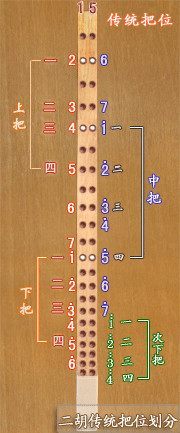Super practical erhu changing skills summary + demonstration
In erhu playing, changing the handle is the most important and the most used skill in the left hand. Many people do not have a very thorough understanding of the changing of the erhu. I have compiled the skills of changing the handle of the erhu for everyone. I hope it will be helpful to everyone!
The order of the Erhu handle
First learn to change the open strings to clarify the distance between the two positions. It is best to play the tone of the switch in the position where the switch is not changed, remember its pitch, and then practice the switch, which is conducive to proofreading the tone of the switch. Swapping should be done while playing open strings.

empty string changer
The second step is to learn to switch with the same finger. Pay attention to the relaxation of the left hand sliding and the coordination of the arm, elbow, thumb and other fingers when changing the handle.

traditional handle
The third step is to learn to change the handle. Slide the finger of the previous note to the new handle, and the finger of the next note will fall down according to the rhythm. In this way, a passing sound (medium sound) of changing the handle is brought out. This sound is not only allowed but also necessary during practice. It should be drawn clearly and in tune, and then gradually weaken its traces after being proficient.


The fourth step is to learn more and more fingers. In the upward movement, the finger of the previous note and the finger of the next note alternate in the process of changing the handle, and the finger of the latter note slides to the new position, and the action is similar to changing the handle with the same finger. In the downward movement, the finger of the previous note is still slid to the new eight position, and the finger of the latter note falls according to the rhythm. Finally learn to stretch the fingers and change the handle. This method is used a lot in the high handle position change, that is, the arm and thumb are not moved, and a single finger is stretched to press the adjacent handle, and then the arm, hand and thumb can adjust their position on the new handle position.


In beginners, you should first learn and consolidate the first four kinds of handlebars from one to three positions. As for the handlebars between the stretch finger and the high position and the low position, you can learn later.
Notes on changing the handle
The switch has the function of expanding the sound range and effect. In the use of fingers, the changer can be divided into the same finger changer, the different finger changer and the open string sound changer; in terms of speed, it can be divided into slow changer and fast changer; in terms of distance, it can be divided into small changer There are certain differences in the action of the handle, the big change handle and the jump handle.
The same finger switch is performed by one finger moving by pressing the strings. This kind of change generally adopts the method of sliding finger, but the sliding finger does not necessarily have a portamento, and the portamento will only be revealed when the speed is slow and the bow is used to match it.
Different fingers change the handle with different fingers. When performing this kind of change, the strings should not be separated from the fingers, that is, when the fingers of the back note are not pressed on the strings, the fingers of the front note should not be lifted off the strings prematurely, otherwise it is easy to produce an empty string sound. . Open string tone change is to have an open string tone between two different position notes. If there is no need for portamento when changing the handle of the open string, the change of the handle should be carried out when the open string is played.
Players should pay special attention to the following points when changing the handle:
1. After changing the handle down, the big arm should be lowered along with it, and it should not remain in the upper handle position.
2. The positioning of the first finger after changing the handle must be accurate, and the distance between the fingers of each finger should be properly adjusted according to the phoneme of the middle handle.
3. Replacing the handle Yes, the concept of the handle position has been determined to be placed on the forearm, not on the part of the tiger's mouth.
Fourth, when changing the handle, the tiger's mouth must be moved first, and the fingers must be moved after, so that the movement of the handle can be coordinated and the pronunciation is coherent.
5. When the middle position is changed back to the upper position, the tiger's mouth will touch a thousand pounds, which means that the upper position is in place, otherwise it will easily lead to the bad tendency of one finger to be on the high side.
6. The handle should be moved vertically up and down, so as not to cause the piano bar to shake too much back and forth during the performance.
7. The tightness of the tiger's mouth is appropriate. If the tiger's mouth is not loosened when changing the handle, it will cause the movement to be difficult, making it difficult to change the handle; after the handle is in place, if the tiger's mouth cannot clamp the piano rod in time to "brake", it will cause the handle to cross the limit. .
 渝公网安备 50010702504639号
渝公网安备 50010702504639号